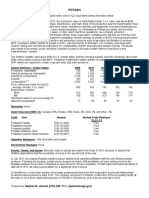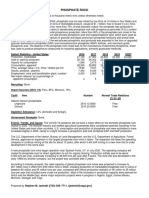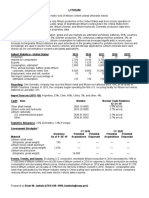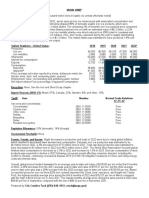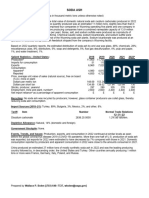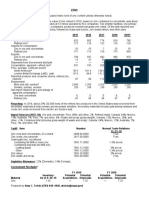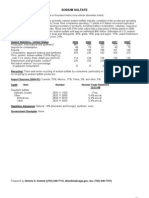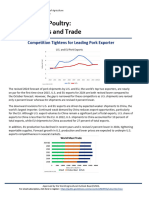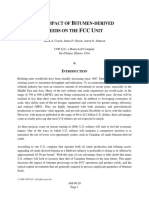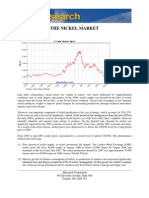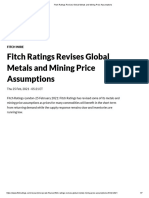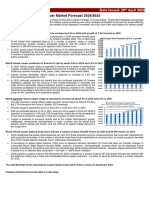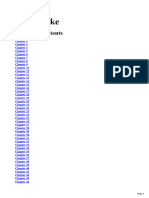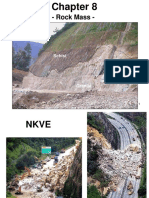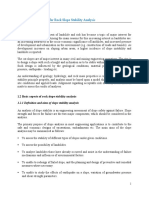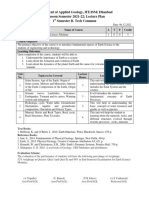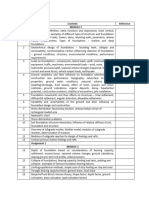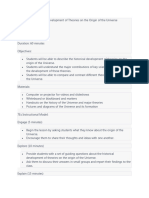Mcs2022 Potash
Mcs2022 Potash
Uploaded by
Solaris VeritatisCopyright:
Available Formats
Mcs2022 Potash
Mcs2022 Potash
Uploaded by
Solaris VeritatisCopyright
Available Formats
Share this document
Did you find this document useful?
Is this content inappropriate?
Copyright:
Available Formats
Mcs2022 Potash
Mcs2022 Potash
Uploaded by
Solaris VeritatisCopyright:
Available Formats
POTASH
[Data in thousand metric tons of potassium oxide (K2O) equivalent unless otherwise noted]
Domestic Production and Use: In 2021, the estimated sales value of marketable potash, free on board (f.o.b.) mine,
was $520 million, which was 24% higher than that in 2020. Potash denotes a variety of mined and manufactured salts
that contain the element potassium in water-soluble form. In agriculture, the term potash refers to potassic fertilizers,
which are potassium chloride (KCl), potassium sulfate or sulfate of potash (SOP), and potassium magnesium sulfate
(SOPM) or langbeinite. Muriate of potash (MOP) is an agriculturally acceptable mix of KCl (95% pure or greater) and
sodium chloride for fertilizer use. The majority of U.S. production was from southeastern New Mexico, where two
companies operated two underground mines and one deep-well solution mine. Sylvinite and langbeinite ores in New
Mexico were beneficiated by flotation, dissolution-recrystallization, heavy-media separation, solar evaporation, and
(or) combinations of these processes. In Utah, two companies operated three facilities. One company extracted
underground sylvinite ore by deep-well solution mining. Solar evaporation crystallized the sylvinite ore from the brine
solution, and a flotation process separated the MOP from byproduct sodium chloride. The firm also processed
subsurface brines by solar evaporation and flotation to produce MOP at its other facility. Another company processed
brine from the Great Salt Lake by solar evaporation to produce SOP and other byproducts.
The fertilizer industry used about 85% of U.S. potash sales, and the remainder was used for chemical and industrial
applications. About 60% of the potash produced was SOPM and SOP, which are required to fertilize certain chloride-
sensitive crops. The remainder of production was MOP and was used for agricultural and chemical applications.
Salient Statistics—United States: 2017 2018 2019 2020 2021e
Production, marketable1 480 520 510 460 480
Sales by producers, marketable1 490 520 480 500 530
Imports for consumption 5,860 5,710 5,150 5,370 7,000
Exports 128 105 145 147 100
Consumption, apparent1, 2 6,200 6,100 5,500 5,700 7,400
Price, average, all products,3 f.o.b. mine, dollars per ton of K2O 770 750 820 850 980
Price, average, muriate, f.o.b. mine, dollars per ton of K2O 410 440 480 450 550
Employment, mine and mill, number 900 900 900 900 900
Net import reliance4 as a percentage of apparent consumption 92 92 91 92 93
Recycling: None.
Import Sources (2017–20): Canada, 75%; Russia, 10%; Belarus, 8%; and other, 7%.
Tariff: Item Number Normal Trade Relations
12–31–21
Potassium nitrate 2834.21.0000 Free.
Potassium chloride 3104.20.0000 Free.
Potassium sulfate 3104.30.0000 Free.
Potassic fertilizers, other 3104.90.0100 Free.
Depletion Allowance: 14% (domestic and foreign).
Government Stockpile: None.
Events, Trends, and Issues: In 2021, U.S. potash consumption and trade reached record levels driven by high crop
prices, increased planted crop area, and increased crop exports. This was a continuation of the trend that began late
in 2020, as markets rebounded from poor weather conditions in the growing season and high potash stocks. The
North American price of potash also increased substantially owing to increased consumption and tighter supplies.
Industrial potash consumption continued to be lower, primarily for oil- and gas-well-drilling additives. The number of
active oil- and gas-well-drilling rigs gradually increased throughout the year but was still well below the level before
the COVID-19 pandemic.
On November 9, 2021, a proposed revised U.S. critical minerals list was published in the Federal Register (86 FR
62199). The new list contained 50 individual mineral commodities; proposed changes were the addition of nickel and
zinc and the removal of helium, potash, rhenium, strontium, and uranium, which were included in the 2018 critical
minerals list.
Prepared by Stephen M. Jasinski [(703) 648–7711, sjasinsk@usgs.gov]
POTASH
World potash consumption in 2021 for fertilizers was estimated to have increased to 45 million tons from 44 million
tons in 2020, as demand peaked in the first half of the year in major consuming regions. Asia and South America
continued to be the leading consuming regions. North America and South America and southeast Asia had the largest
increases in consumption over that of 2020. World potash production increased, owing primarily to increased output
in the major exporting countries of Belarus, Canada, and Russia to meet high demand in the first half of the year.
In August 2021, the United States imposed economic sanctions on Belarus for violations of international law, which
included the state-run potash producer. The sanctions did not include the state-run exporting company for Belarus,
and potash imports from Belarus continued, but at a lower volume because many buyers used other sources owing to
uncertainty of future sanctions.
A new potash mine was in the development stage and pending operating permits in Osceola County, MI. The
proposed solution mine would have an initial production capacity of 650,000 tons per year of MOP and was planned
to increase to 1 million tons per year.
World annual potash capacity was projected to increase to near 69 million tons in 2025 from 62.3 million tons in 2021.
Most of the increase would be MOP from new mines and expansion projects in Belarus, Canada, and Russia. New
SOP mines were planned in Australia and Eritrea, and a polyhalite mine in the United Kingdom would also contribute
to the capacity growth. New MOP mines in Brazil, Canada, Ethiopia, Morocco, Spain, and the United States were
planned to begin operation past 2025 but could be delayed because of future unfavorable economic conditions or lack
of funding.
World Mine Production and Reserves: Reserves for Russia were updated with the Australasian Joint Ore Reserves
Committee (JORC)-compliant reserves reported by the producing companies.
Mine production Reserves5
2020 2021e Recoverable ore K2O equivalent
United States1 460 480 970,000 220,000
Belarus 7,400 8,000 3,300,000 750,000
Brazil 254 210 10,000 2,300
Canada 13,800 14,000 4,500,000 1,100,000
Chile 900 900 NA 100,000
China 6,000 6,000 NA 350,000
Germany 2,200 2,300 NA 150,000
Israel 2,280 2,300 NA 6Large
Jordan 1,590 1,600 NA 6Large
Laos 270 300 500,000 75,000
Russia 8,110 9,000 NA 400,000
Spain 420 400 NA 68,000
Other countries 360 370 1,500,000 300,000
World total (rounded) 44,000 46,000 >11,000,000 >3,500,000
World Resources:5 Estimated domestic potash resources total about 7 billion tons. Most of these lie at depths
between 1,800 and 3,100 meters in a 3,110-square-kilometer area of Montana and North Dakota as an extension of
the Williston Basin deposits in Manitoba and Saskatchewan, Canada. The Paradox Basin in Utah contains resources
of about 2 billion tons, mostly at depths of more than 1,200 meters. The Holbrook Basin of Arizona contains resources
of about 0.7 to 2.5 billion tons. A large potash resource lies about 2,100 meters under central Michigan and contains
more than 75 million tons. Estimated world resources total about 250 billion tons.
Substitutes: No substitutes exist for potassium as an essential plant nutrient and as an essential nutritional requirement
for animals and humans. Manure and glauconite (greensand) are low-potassium-content materials that can be
profitably transported only short distances to crop fields. Glauconite is used as a potassium source for organic farming.
e
Estimated. NA Not available.
1
Data are rounded to no more than two significant digits to avoid disclosing company proprietary data.
2
Defined as sales + imports – exports.
3
Includes MOP, SOP, and SOPM. Does not include other chemical compounds that contain potassium.
4
Defined as imports – exports.
5
See Appendix C for resource and reserve definitions and information concerning data sources.
6
Israel and Jordan recover potash from the Dead Sea, which contains nearly 2 billion tons of potassium chloride.
U.S. Geological Survey, Mineral Commodity Summaries, January 2022
You might also like
- UNSW MINE3310 Rock MechanicsDocument215 pagesUNSW MINE3310 Rock MechanicsBikesh ShresthaNo ratings yet
- Schlumberger Oilfield ReviewDocument58 pagesSchlumberger Oilfield ReviewBahman Madadi100% (2)
- Chlor-Alkali Market ReportDocument38 pagesChlor-Alkali Market Reportshine2ricaNo ratings yet
- Profile On The Production of Sodium Silicate PDFDocument27 pagesProfile On The Production of Sodium Silicate PDFNebiyu Samuel100% (2)
- Significance of Harker Diagram: Department of Geology, University of PeshawarDocument7 pagesSignificance of Harker Diagram: Department of Geology, University of PeshawarayeshamajidNo ratings yet
- mcs2023 PotashDocument2 pagesmcs2023 PotashSolaris VeritatisNo ratings yet
- Mcs2020 PotashDocument2 pagesMcs2020 PotashSolaris VeritatisNo ratings yet
- Mcs2021 PotashDocument2 pagesMcs2021 PotashSolaris VeritatisNo ratings yet
- Mcs 2014 PotasDocument2 pagesMcs 2014 Potasulfah nur khikmahNo ratings yet
- Mcs2021 LithiumDocument2 pagesMcs2021 LithiumkikiNo ratings yet
- LithiumDocument2 pagesLithiumDhruv BhattNo ratings yet
- USGS2Document2 pagesUSGS2kentasakiNo ratings yet
- mcs2023 PhosphateDocument2 pagesmcs2023 Phosphateكركشندي أفندي Karkshndy afndyNo ratings yet
- Mcs2021 PhosphateDocument2 pagesMcs2021 PhosphatemitheleshpurohitNo ratings yet
- Lithium ReservesDocument2 pagesLithium ReservesROOPDIP MUKHOPADHYAYNo ratings yet
- Mcs2023 Iron OreDocument2 pagesMcs2023 Iron Oresantanu ChowdhuryNo ratings yet
- Mcs 2019 LithiumDocument2 pagesMcs 2019 LithiumDavid ArzeNo ratings yet
- Usgs Magnesite Production and ReservesDocument2 pagesUsgs Magnesite Production and ReservesaaNo ratings yet
- mcs2023 Soda AshDocument2 pagesmcs2023 Soda AshHuifeng LeeNo ratings yet
- mcs2023 LimeDocument2 pagesmcs2023 LimeFAJJAR OKTAVIANTO OKTAVIANTONo ratings yet
- Mcs2021 NickelDocument2 pagesMcs2021 NickelTogarHarahapNo ratings yet
- 6-7-Titamio USGS 2021Document2 pages6-7-Titamio USGS 2021Raphael NevesNo ratings yet
- Zinc StatisticsDocument2 pagesZinc StatisticsROOPDIP MUKHOPADHYAYNo ratings yet
- Mcs 2009 NasulDocument2 pagesMcs 2009 NasulcatluriNo ratings yet
- mcs2023 StrontiumDocument2 pagesmcs2023 StrontiumDragos MihaiNo ratings yet
- SAQ Module-4 Demand-SupplyDocument7 pagesSAQ Module-4 Demand-SupplyAngel BonifacioNo ratings yet
- Livestock - Poultry - Cleaned Jan24Document16 pagesLivestock - Poultry - Cleaned Jan24José VmNo ratings yet
- Indiumcs 05Document2 pagesIndiumcs 05skywayzNo ratings yet
- SUMMARY SLIDE DECK Salt Forum 2022 IMFORMEDDocument27 pagesSUMMARY SLIDE DECK Salt Forum 2022 IMFORMEDbogdanberchiNo ratings yet
- Tungsten Production and Use DataDocument2 pagesTungsten Production and Use DatadholteNo ratings yet
- UOP FCC Bitumen Processing Case StudyDocument22 pagesUOP FCC Bitumen Processing Case Studysaleh4060No ratings yet
- Produccion de Minerales de Titanio Por PaisesDocument16 pagesProduccion de Minerales de Titanio Por PaisesantonNo ratings yet
- mcs2024 CopperDocument2 pagesmcs2024 CopperLucas HerreraNo ratings yet
- Ilovepdf MergedDocument4 pagesIlovepdf MergedPrice Sanchez JoseNo ratings yet
- 13 March 2008Document22 pages13 March 2008shine2ricaNo ratings yet
- MANGANESEDocument6 pagesMANGANESEAndi Baso Lovan AltamarNo ratings yet
- Mcs2023-Platinum-Group (Quantities of Metals)Document2 pagesMcs2023-Platinum-Group (Quantities of Metals)Miguel Angel Murillo ZapataNo ratings yet
- FER-White Paper-Sulphur Market VolatilityDocument4 pagesFER-White Paper-Sulphur Market VolatilityvhlmNo ratings yet
- Brazilian Minerals EconomyDocument5 pagesBrazilian Minerals EconomyjearodriguesNo ratings yet
- AFS 2017 Global Casting ProductionDocument5 pagesAFS 2017 Global Casting ProductionirmamendoNo ratings yet
- The Nickel Market: I. Historical PricesDocument4 pagesThe Nickel Market: I. Historical PricesTuan AnhNo ratings yet
- Mcs2022 NickelDocument2 pagesMcs2022 Nickelagus margana womalNo ratings yet
- Fitch Ratings Revises Global Metals and Mining Price AssumptionsDocument7 pagesFitch Ratings Revises Global Metals and Mining Price AssumptionsRafa BorgesNo ratings yet
- 2024 04 29 - ICSG Forecast Press ReleaseDocument2 pages2024 04 29 - ICSG Forecast Press Releaseuna_vegaNo ratings yet
- mcs2020.pdf - Mineral Commodity Summaries 2020Document1 pagemcs2020.pdf - Mineral Commodity Summaries 2020Abg. Williams GarciaNo ratings yet
- Coal Policy-Coaltrans Asia 2015-RevDocument16 pagesCoal Policy-Coaltrans Asia 2015-Revbrata19No ratings yet
- #GIR Investor Executive Summary V6-2018Document5 pages#GIR Investor Executive Summary V6-2018Neil GutierrezNo ratings yet
- 3 Mining Platform Mike Da CostaDocument20 pages3 Mining Platform Mike Da CostaJEAN MICHEL ALONZEAUNo ratings yet
- RVA - FTTH Council Presentation 09-2010Document8 pagesRVA - FTTH Council Presentation 09-2010StimulatingBroadband.comNo ratings yet
- MDMW Perlite03Document2 pagesMDMW Perlite03miningnovaNo ratings yet
- AGY Research ReportDocument14 pagesAGY Research ReportHoward QinNo ratings yet
- Cameron Alexander, Director Metals Demand Asia, GFMS: August 2018Document13 pagesCameron Alexander, Director Metals Demand Asia, GFMS: August 2018Olivia JacksonNo ratings yet
- mcs2023 CementDocument2 pagesmcs2023 Cementliyingge001No ratings yet
- Oilseeds and Products Annual - Jakarta - Indonesia - ID2022-0007Document23 pagesOilseeds and Products Annual - Jakarta - Indonesia - ID2022-0007GabrielNo ratings yet
- 2016 09 Nickel Market Developments PDFDocument12 pages2016 09 Nickel Market Developments PDFsupriNo ratings yet
- Glo DGF Ocean Market UpdateDocument23 pagesGlo DGF Ocean Market UpdateKicki AnderssonNo ratings yet
- Industry in LibyaDocument4 pagesIndustry in LibyaSalem GarrabNo ratings yet
- Livestock and Poultry: World Markets and TradeDocument18 pagesLivestock and Poultry: World Markets and TradeCazare MamaiaNo ratings yet
- NickelMkt GoodDocument4 pagesNickelMkt Goodtdazzv13784No ratings yet
- Mcs2020 SiliconDocument2 pagesMcs2020 SiliconSyed Muzammil AbbasNo ratings yet
- WPIC Platinum Quarterly Q2 2024Document27 pagesWPIC Platinum Quarterly Q2 2024caphe011003No ratings yet
- World Sulphur OutlookDocument28 pagesWorld Sulphur OutlooksaeidNo ratings yet
- Food Outlook: Biannual Report on Global Food Markets: November 2022From EverandFood Outlook: Biannual Report on Global Food Markets: November 2022No ratings yet
- Eric Flint & Marilyn Kosmatka - Time SpikeDocument321 pagesEric Flint & Marilyn Kosmatka - Time SpikekpergNo ratings yet
- Tsunamis DescriptionDocument5 pagesTsunamis DescriptionGrayNo ratings yet
- GR 5 Unit 2 - Rocks and MineralsDocument5 pagesGR 5 Unit 2 - Rocks and MineralsprekshapatelindNo ratings yet
- Minerals and Energy Resources Padhai Ak Mazza Best Handwritten Notes 2023Document6 pagesMinerals and Energy Resources Padhai Ak Mazza Best Handwritten Notes 2023Prince Sharma100% (6)
- Energies: A Model of Reservoir Permeability Evolution During Oil ProductionDocument16 pagesEnergies: A Model of Reservoir Permeability Evolution During Oil ProductionAiwarikiaarNo ratings yet
- Uwi - Foun1101 - Caribbean Civilization - Topic 1Document15 pagesUwi - Foun1101 - Caribbean Civilization - Topic 1payel02000100% (8)
- Chapter8-Rockmass PRTDocument107 pagesChapter8-Rockmass PRTSky FireNo ratings yet
- Science Reviewer Science 8Document4 pagesScience Reviewer Science 8stevelaurence1545No ratings yet
- 17CV35Document2 pages17CV35AnupEkboteNo ratings yet
- Chapter 1 Principles For Rock Slope Stability AnalysisDocument14 pagesChapter 1 Principles For Rock Slope Stability AnalysiskkgbkjNo ratings yet
- Types of Rocks QuizDocument6 pagesTypes of Rocks Quizzhiweiwong123No ratings yet
- 1 Summative Test Science 10Document3 pages1 Summative Test Science 10kimjay languitaNo ratings yet
- Written - Group 2Document8 pagesWritten - Group 2Janine Arielle DanaoNo ratings yet
- Introduction To Rock MechanicsDocument38 pagesIntroduction To Rock MechanicsSid WorldNo ratings yet
- Earth Science Modular 2Document1 pageEarth Science Modular 2Prasann KatiyarNo ratings yet
- Ardgermeli Kutu Kirişli Bir Viyadüğün Deprem Performans DeğerlendirmesiDocument152 pagesArdgermeli Kutu Kirişli Bir Viyadüğün Deprem Performans DeğerlendirmesiYunus Emre ÖzçelikNo ratings yet
- Uncertainty in Depth: Reduced: Industry Steering Committee On Wellbore Survey AccuracyDocument23 pagesUncertainty in Depth: Reduced: Industry Steering Committee On Wellbore Survey AccuracyMaxNo ratings yet
- Trackless Mining at Thabazimbi MineDocument7 pagesTrackless Mining at Thabazimbi MineYojan Ccoa CcopaNo ratings yet
- Geography River Coursework IntroductionDocument7 pagesGeography River Coursework Introductionafjwoovfsmmgff100% (2)
- Coban Rondo WaterfallDocument2 pagesCoban Rondo WaterfallFebriana Rachmawati100% (1)
- Lesson PlanDocument2 pagesLesson PlanJimmy ThomasNo ratings yet
- Dolch-Sight Words at A GlanceDocument5 pagesDolch-Sight Words at A Glanceadministrator noonanNo ratings yet
- Earth & Life Science LPDocument15 pagesEarth & Life Science LPAileen gay PayunanNo ratings yet
- Robertson Basins and Plays PosterDocument1 pageRobertson Basins and Plays PosterHerbert MohriNo ratings yet
- Jaime Incer Geo of Lake NicaraguaDocument7 pagesJaime Incer Geo of Lake Nicaraguacarlos.enrique.fonseca1440100% (1)
- R. Krauss 2011 - Beginnings-New Research in The NeolithicDocument231 pagesR. Krauss 2011 - Beginnings-New Research in The NeolithicPaolo BiagiNo ratings yet








